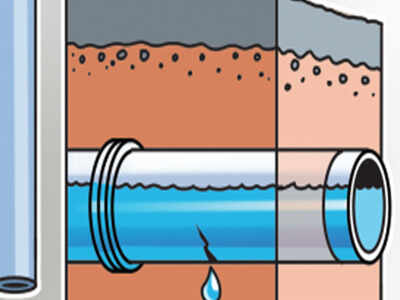- News
- City News
- chandigarh News
- Salinity level in shallow aquifers dropped during lockdown: Study
Salinity level in shallow aquifers dropped during lockdown: Study

A slight reduction in 6% of samples with TDS values exceeding 1,000mg/l after lockdown as compared to the period before the lockdown was noted(Representative image)
CHANDIGARH: Salinity level in shallow aquifers of industrial districts in Punjab dropped during the lockdown imposed to control the spread of Covid-19, according to a joint study done by the National Institute of Hydrology, Roorkee; Punjab State Farmers' Commission and department of soil and water conservation, Punjab.
High salinity levels can have damaging effects on agriculture by reducing productivity and causing environmental degradation. To examine the impact of lockdown on groundwater salinity in Punjab, the study was done in three industrial dominant districts of Ludhiana, Jalandhar, and Moga, comprising an area of about 8,559 square kilometres. For this, 48 groundwater samples, 13 from shallow aquifers of less than 50m depth and 35 from aquifers having a depth range of 50m to 200m were collected from borewells, hand pump and open wells.
The values for total dissolved solids (TDS) observed during the monsoon season (August 2020) and post-monsoon (November–December 2019) were compared with the values taken in June 2020 (pre-monsoon). A total of 60% samples were found to have TDS values above the acceptable limit of 500 mg/l before lockdown post-monsoon season of 2019. During the lockdown period (June 2020), the number of samples with more than the acceptable limit reduced to 45%.
An analysis of samples revealed that the average TDS values dropped by 25% in shallow aquifers after lockdown, while the area under TDS values in acceptable limit increased by 23% as compared to those found in the monsoon season of 2019. In deeper aquifers, an increase of only 3% area under TDS values in acceptable limit was found.
A slight reduction in 6% of samples with TDS values exceeding 1,000mg/l after lockdown as compared to the period before the lockdown was noted.
High salinity levels can have damaging effects on agriculture by reducing productivity and causing environmental degradation. To examine the impact of lockdown on groundwater salinity in Punjab, the study was done in three industrial dominant districts of Ludhiana, Jalandhar, and Moga, comprising an area of about 8,559 square kilometres. For this, 48 groundwater samples, 13 from shallow aquifers of less than 50m depth and 35 from aquifers having a depth range of 50m to 200m were collected from borewells, hand pump and open wells.
The values for total dissolved solids (TDS) observed during the monsoon season (August 2020) and post-monsoon (November–December 2019) were compared with the values taken in June 2020 (pre-monsoon). A total of 60% samples were found to have TDS values above the acceptable limit of 500 mg/l before lockdown post-monsoon season of 2019. During the lockdown period (June 2020), the number of samples with more than the acceptable limit reduced to 45%.
An analysis of samples revealed that the average TDS values dropped by 25% in shallow aquifers after lockdown, while the area under TDS values in acceptable limit increased by 23% as compared to those found in the monsoon season of 2019. In deeper aquifers, an increase of only 3% area under TDS values in acceptable limit was found.
A slight reduction in 6% of samples with TDS values exceeding 1,000mg/l after lockdown as compared to the period before the lockdown was noted.
FacebookTwitterLinkedinEMail
end of article
Trending Topics
Top Stories Right Now
- indiaCovid live: IPL suspended for this season, BCCI vice-president Rajeev Shukla say...
- sportsIPL 2021 suspended, BCCI goes into a huddle to finalise postponement
- indiaSecond wave: New Covid-19 cases may peak today, say experts
- entertainmentKangana Ranaut's Twitter account suspended
- cityDelhi: Airport to hospital, French O2 plant up and running in 18 hrs
Quick Links
Delhi Air PollutionDelhi TemperatureChennai WeatherBangalore TemperatureCovid vaccination centres in DelhiCoronavirus in DelhiRTPCR test in GurgaonHyderabad RainPollution level in BangaloreDelhi SmogDelhi TemperatureNoida AQIGurgaon AQI todayFire in MumbaiMumbai RainsCovid 19 RT PCR Test in NoidaDelhi AQI todaySrinagar encounter